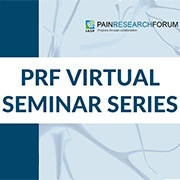Editor’s note: This is the 19th in a series of weekly PRF seminars designed to help keep the pain research community connected during the COVID-19 pandemic and to provide all members of that community with virtual educational opportunities. The seminar series is supported by the Center for Advanced Pain Studies at the University of Texas at Dallas, US.

On September 14, the IASP Pain Research Forum hosted a seminar with Tayler Sheahan, PhD, and Eileen Nguyen, MD/PhD student, both from the University of Pittsburgh, US. A Q&A session moderated by Mark Hoon, PhD, National Institutes of Health (NIH), NIDCR, Bethesda, US, followed the presentation.
A recording of this webinar will soon be freely available to IASP members at the IASP Pain Education Resource Center (PERC).
Here are abstracts from the presenters:
The Cellular Basis for Morphine-Induced Itch (Eileen Nguyen)
Morphine-induced itch is a very common and debilitating side effect that occurs in laboring women who receive epidural analgesia and in patients who receive spinal morphine for relief of perioperative pain. Although antihistamines are still widely prescribed for the treatment of morphine-induced itch, their use is controversial because the cellular basis for morphine-induced itch remains unclear. We found that neuraxial morphine causes itch through neurons and not mast cells. In particular, we found that spinal dynorphin (Pdyn) neurons are both necessary and sufficient for morphine-induced itch. Notably, pharmacological rescue of dynorphin signaling alleviated morphine-induced itch in mice and non-human primates. Thus, our findings not only reveal that morphine causes itch through a mechanism of disinhibition but also challenge the long-standing use of antihistamines, thereby informing the treatment of perioperative pain.
The Neurokinin-1 Receptor Is Expressed With Gastrin-Releasing Peptide Receptor in Spinal Interneurons and Modulates Itch (Tayler Sheahan)
Itch is a prevalent health problem in need of safe and effective treatments. While the spinal cord is known to be a critical hub in the processing of somatosensory input, which spinal neurons process itch input and how itch signals are encoded within the spinal cord are not fully understood. In this seminar, I will present our recent findings demonstrating that spinal neurons that express the neurokinin-1 receptor (NK1R) mediate itch in mice and are positioned at the center of spinal itch transmission. Evidence will be presented from behavioral studies, in situ hybridization analyses, and calcium imaging of the spinal cord. I will then show that NK1R RNA is similarly expressed within the spinal cord dorsal horn of humans. In light of these findings, the seminar will conclude with a discussion of an updated model of spinal itch transmission.
About the presenters
Eileen Nguyen is an MD/PhD student at the University of Pittsburgh, where she is completing her PhD in the laboratory of Sarah Ross. Prior to starting in the Pitt MSTP, Nguyen obtained her BS in neuroscience at the University of California, Los Angeles. For her undergraduate thesis, she worked in the joint lab of Michael Gorin and Anna Matynia, where she examined the role of light-sensitive opsins in light-induced ocular pain. Building on her interest in pain research, she moved to the National Institutes of Health, where she did a post-bac with Alex Chesler and Claire Le Pichon, investigating pathways for chronic pain signaling. Now, as a graduate student in the Ross Lab at the University of Pittsburgh, Nguyen is interested in identifying CNS circuits that could be targeted for the clinical management of pain and itch.
Tayler Sheahan, PhD, earned her doctorate in neuroscience working with Rob Gereau at Washington University in St. Louis. Her doctoral work included several studies that were broadly aimed at bridging the translational gap between rodent and human pain research by asking questions such as, How do we measure pain in rodents? and How similar are the neurons that sense pain in mice and humans? In 2018, Sheahan joined Sarah Ross’ lab as a postdoctoral fellow in the Pittsburgh Center for Pain Research at the University of Pittsburgh. Her current research is focused on understanding how information from our environment is detected by the skin, encoded within the spinal cord, and conveyed to the brain to give rise to the sensations of pain and itch. Sheahan’s work is currently supported by an NIH NRSA Postdoctoral Fellowship and NIH Loan Repayment Program Award.
About the moderator
Mark Hoon, PhD, earned his PhD in the lab of John Findlay at the University of Leeds, where he studied the molecular components in invertebrate vision. After completing a NATO postdoctoral fellowship in Freiburg, Germany, Hoon joined Nicholas Ryba's lab at NIDCR to investigate taste. Over a period of 15 years, in collaboration with Charles Zuker’s laboratory at Columbia University, Hoon and colleagues discovered the receptors and cells required for sweet, bitter, and sour taste. At the end of 2006, Hoon started his own lab working on deciphering signaling pathways involved in mammalian somatosensation. The lab has been dissecting the cellular basis for thermosensation and pain signaling, and recently uncovered the neural pathway for itch by studying neuropeptides. Hoon's group is continuing to study peripheral mechanisms of somatosensation using molecular genetic techniques.
Join the conversation about the seminar on Twitter @PainResForum #PRFSeminar
We thank the Center for Advanced Pain Studies at the University of Texas at Dallas, US, for its support of the PRF seminar series.



